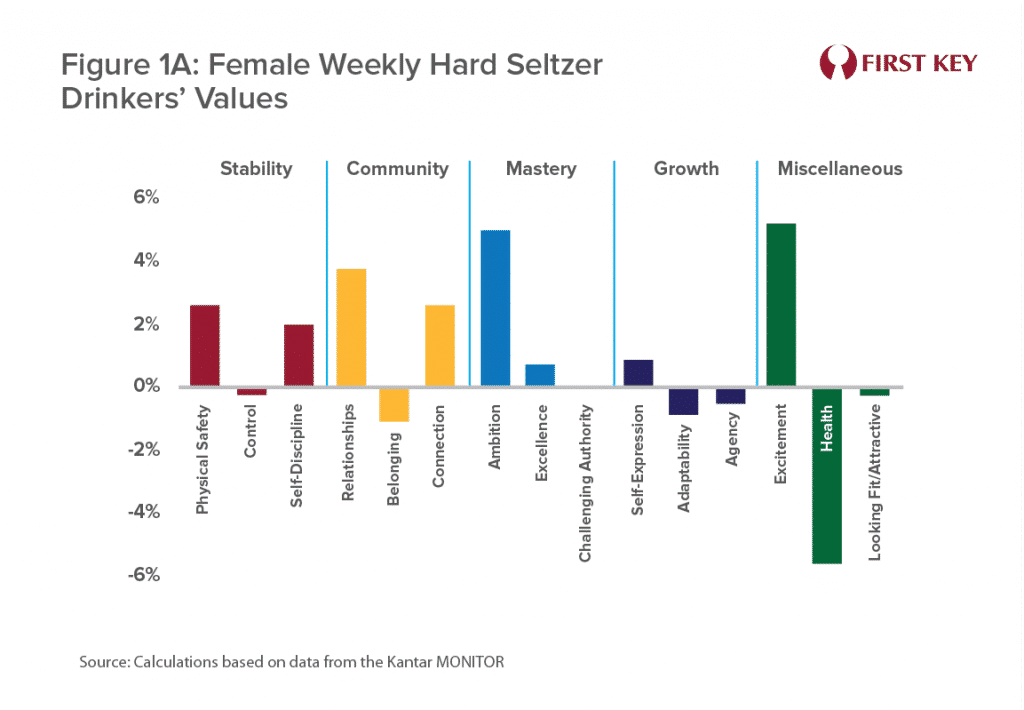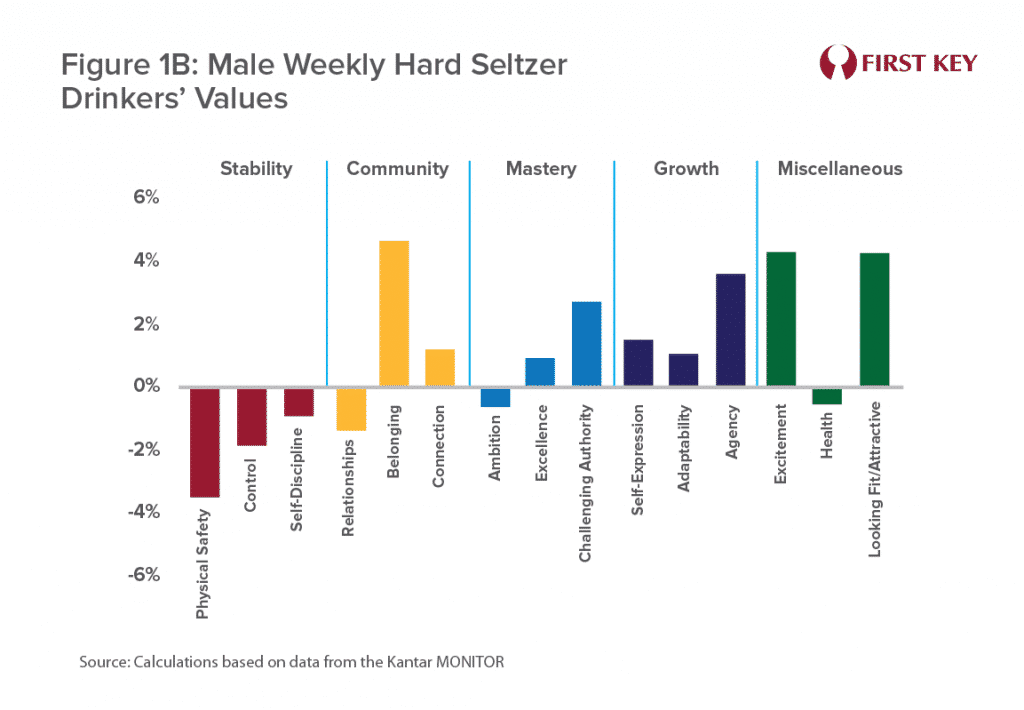Will the real hard seltzer drinker please stand up?
Yes, we know there’s no such thing as one “real” hard seltzer drinker. But there are two emerging narratives about the people who typically drink hard seltzer, and more importantly, why they drink it. The first narrative is fairly widespread and holds that the core drinker’s connection to the category has a lot to do with its role as a supposedly healthier alternative – which may conjure up images of working professional types enjoying hard seltzers with friends or co-workers after a long day at work or at small social gatherings (in non-pandemic times, of course).
Yet if you’ve been paying attention to the press or to social media, you’ve probably had at least a glimpse of a subculture that’s rapidly becoming associated with hard seltzer – men in their 20s with a streak of machismo, a bit of a herd instinct, and a consequences-be-damned spontaneity. It doesn’t take much online searching to find videos posted on social media of guys with cans of hard seltzer in their hands, congregating in the woods or on the beach, removed from civilization and releasing pent-up tensions with almost primal behavior – ranging from whooping and chanting to performing stunts that are too rowdy for prime time. Many articles refer to them as “bros” (which is understandable but arguably not the most fitting descriptor), while others are far more unflattering than that. And they seem to have embraced hard seltzer as a badge of everything they value.[i]
This group is only a very small part of the hard seltzer drinker base, but the data indicates they may already have become indelibly associated with the category. This may or may not be welcome information to those selling hard seltzer, but the truth is that it may not be an entirely bad thing.
Let’s investigate that second statement first, before we circle back to the data.
It’s not unprecedented for a brand or product to spawn associations with whole subcultures. Those subcultures may or may not represent the majority of the brand’s customers – in fact they seldom represent more than a particularly colorful minority – but they can come to define the brand to many who see it from the outside.
Think of Harley-Davidson. The vast majority of the brand’s owners are upper-income, mostly working professional men and women. Yet for most people the name Harley-Davidson evokes images of a tough-talking, rough-looking guy with a belt-length beard, wearing a bandana and a T-shirt festooned with rebellious slogans. And despite how relatively rare he actually is among Harley riders, his image has become entrenched in the brand lore.
But here’s one thing to keep in mind: while those white-collar riders don’t necessarily embrace the image of the classic “biker dude,” many do aspire to the values he represents – freedom and independence. And so the subculture that becomes associated with a brand or category can become a powerful if unintended symbol, reinforcing the brand values – a mixed blessing, and one that a brand like Harley-Davidson must manage carefully.[ii]
Hard seltzer is already flirting with an analogous situation. In order to shed some light on this drinker dichotomy, we used data from the Kantar MONITOR, America’s longest-running survey of the population’s attitudes and values. We analyzed the data to create a “values profile” of those who drink hard seltzer at least once a week, which will be explained in a little more detail shortly. But what may be surprising is how very different the values expressed by female and male hard seltzer drinkers are – and the extent to which the picture of male drinkers sketched by the data resembles those guys cutting loose in the woods.
The values profiles of women and men who drink hard seltzer are presented in Figure 1A and Figure 1B respectively. These are essentially “life values” and not necessarily directedly related to hard seltzer in their minds. The survey provides a long list of values and asks the respondents to rate how important each one is in their life today. The individual bars reflect the relative importance ascribed to each value, compared to norms established across drinker types. The values are color-coded in order to group them by common themes.


One finding that stands out: “finding excitement and sensation in life” is among the most important values for both women and men who drink hard seltzer.
From there the values profiles generally diverge. Looking across Figure 1A, the sketch of female hard seltzer drinkers portrays someone who values ambition, with a high degree of self-discipline. Perhaps not surprisingly they also place great importance on one-on-one relationships and physical safety.
Starting with that emphasis on excitement and sensation, Figure 1B portrays a male drinker who evokes the subculture we’ve discussed in many ways. He values “belonging to a group” above all else. Challenging authority and self-expression are important to him as well, while stability-oriented values – control, self-discipline, and in particular physical safety – are barely on his radar.
Note that, contrary to the conclusions of many, “proactively managing my health” is actually less important relatively speaking for hard seltzer drinkers, and in particular for female drinkers. We would tentatively suggest that, while perceived health benefits may indeed be a draw for some who drink hard seltzer, that group doesn’t appear to be large enough to make their presence felt in the aggregate. However, male hard seltzer drinkers do place a lot of importance on “looking fit and attractive,” so maybe that’s the spin on health that hasn’t been discussed enough.
This doesn’t mean that the typical male hard seltzer drinker fits the literal description of the subculture described in those articles. In fact, we find it extremely unlikely. But, like many Harley riders, that subculture’s values may be something many hard seltzer drinkers aspire to – without any desire to express them in such extreme form.
A decade or more from now, those guys blowing off steam on the edges of civilization may have played out their fifteen minutes of fame – or they may have become legendary as “seltzer dudes,” indelibly inscribed in the hard seltzer narrative. They never were, and never maybe, representative of more than a small minority of the drinker base, and so hard seltzer makers may well develop a love-hate relationship with the persona. Yet understanding what that relationship means and doesn’t mean, and managing it well, may be among the critical tasks involved in managing hard seltzer brand meaning.
[i] For some examples of how this narrative is playing out in the press, see https://www.businessinsider.com/white-claw-beloved-by-bros-2019-8 or https://melmagazine.com/en-us/story/white-claw-weekendgunnit-boog-boi-reddit-meme\ Most articles in the press discuss White Claw’s role in this subculture, although a Google search will turn up similar social media posts and videos uploaded by drinkers of other brands as well.
[ii] For an excellent discussion of how brands interact with subcultures and how this perspective is useful to marketers, we recommend How Brands Become Icons, by Douglas B. Holt. Harley-Davidson is discussed in detail in Chapter 7.



